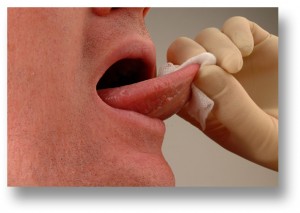
What is the uncontrollable growth of cells invading and causing damage to surrounding tissue? Most of us know this as Cancer. A growth or sore in the mouth that doesn’t go away could be Oral cancer. This includes cancers of the tongue, cheek, lips, floor of the mouth, soft and hard palate, pharynx or throat and sinuses can be life threatening if not diagnosed and treated early. April is Oral cancer awareness month.
What Are the Symptoms of Oral Cancer?
The most common symptoms of oral cancer may include:
- Swellings/thickenings, lumps or bumps, rough spots/crusts/or eroded areas on the lips, gums, or other areas inside the mouth
- The development of velvety white, red, or speckled (white and red) patches in the mouth
- Unexplained bleeding in the mouth
- Unexplained numbness, loss of feeling, or pain/tenderness in any area of the face, mouth, or neck
- Persistent sores on the face, neck, or mouth that bleed easily and do not heal within 2 weeks
- A soreness or feeling that something is caught in the back of the throat
- Difficulty chewing or swallowing, speaking, or moving the jaw or tongue
- Hoarseness, chronic sore throat, or change in voice
- Ear pain
- A change in the way your teeth or dentures fit together
- Dramatic weight loss
If you notice any of these changes, contact your dentist or health care professional immediately.
Who Gets Oral Cancer?
Men face twice the risk of developing oral cancer than women and men over 50 are at the greatest risk. Over 35,000 people were diagnosed with oral cancer in the US in 2008 according to the American Cancer Society.
Risk factors for developing of oral cancer include the following:
- Smoking. Cigarette, cigar, or pipe smokers are six times more likely than nonsmokers to develop oral cancers.
- Smokeless tobacco users. Users of dip, snuff, or chewing tobacco products are 50 times more likely to develop cancers of the cheek, gums, and lining of the lips.
- Excessive consumption of alcohol. Oral cancers are about six times more common in drinkers than in nondrinkers.
- Family history of cancer.
- Excessive sun exposure, especially at a young age.
Over 25% of all oral cancer occurs in people who don’t smoke and only drink occasionally so one can never be complacent.
What Is the Outlook for People With Oral Cancer?
The Survival rate for patients with any stage of pharynx and oral cancers is 81% for one year, with 56% for five years, and 41% for ten years.
How Is Oral Cancer Diagnosed?
During your routine dental exam, your dentist should conduct a screening exam for oral cancer, feeling for any lumps, irregular tissue changes in the neck, head, face and oral cavity as well as looking for sores or discolored tissue or signs and symptoms of oral cancer. He may perform an oral brush biopsy if there is suspect tissue found. The test is painless and involves taking a sample of tissue and analyzing it for abnormal cells. If it is more sever your dentist may recommend a scalpel biopsy which usually requires anesthesia and ay need to be performed by a specialist. It is necessary for early detection before the chance to progress and spread.
How Is Oral Cancer Treated?
The cancerous growth is removed with surgery and usually followed by chemo or radiation therapy to destroy cells that may remain.
What Can I Do to Prevent Oral Cancer?
To prevent oral cancer:
- Don’t smoke or use any tobacco products and drink alcohol in moderation (and refrain from binge drinking).
- Eat a well balanced diet.
- Limit your exposure to the sun. Repeated exposure increases the risk of cancer on the lip, especially the lower lip. When in the sun, use UV-A/B-blocking sun protective lotions on your skin, as well as your lips.
Be diligent in your role for prevention of oral cancer by early detection should you find it with the following:
You can take an active role in detecting oral cancer early, should it occur, by doing the following:
- Conduct a self exam at least once a month. Using a bright light and a mirror, look and feel your lips and front of your gums. Tilt your head back and look at and feel the roof of your mouth. Pull your checks out to view the inside of your mouth, the lining of your cheeks, and the back gums. Pull out your tongue and look at all surfaces; examine the floor of your mouth. Look at the back of your throat. Feel for lumps or enlarged lymph nodes in both sides of your neck and under your lower jaw. Call your dentist’s office immediately if you notice any changes in the appearance of your mouth or any of the signs and symptoms mentioned above.
- See your dentist on a regular schedule. Even with frequent self exams some spots may too small for you to see. The American Cancer society recommends screenings be done every 3 years for everyone over 20 and yearly for those over 40. Ask your dentist to perform and oral exam. Most people don’t know to do this. Early detection can improve the chance for successful treatment.

No comments yet.